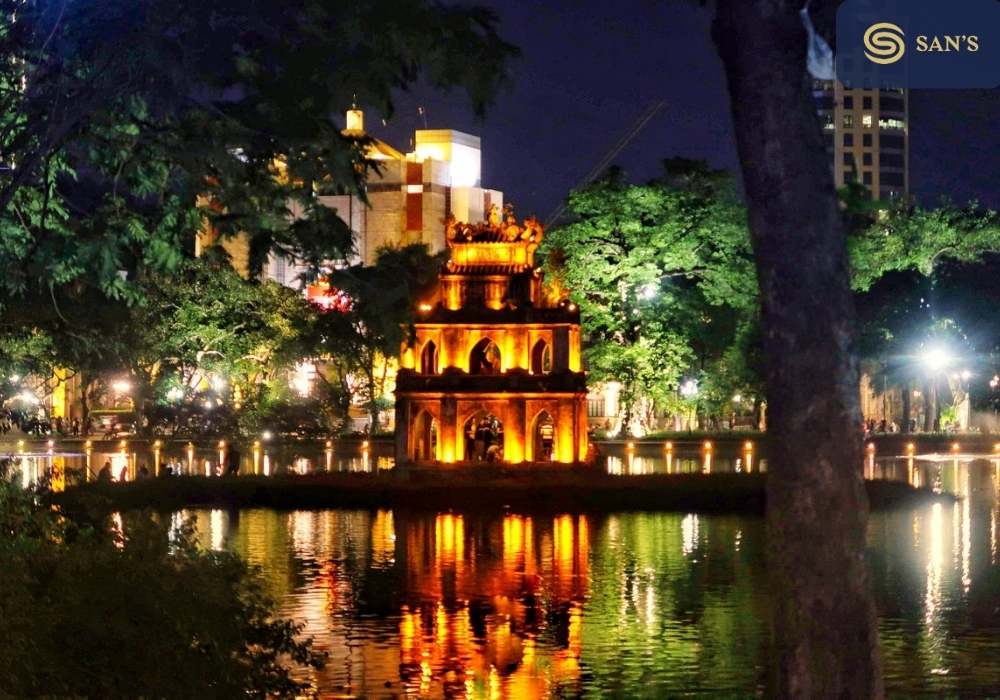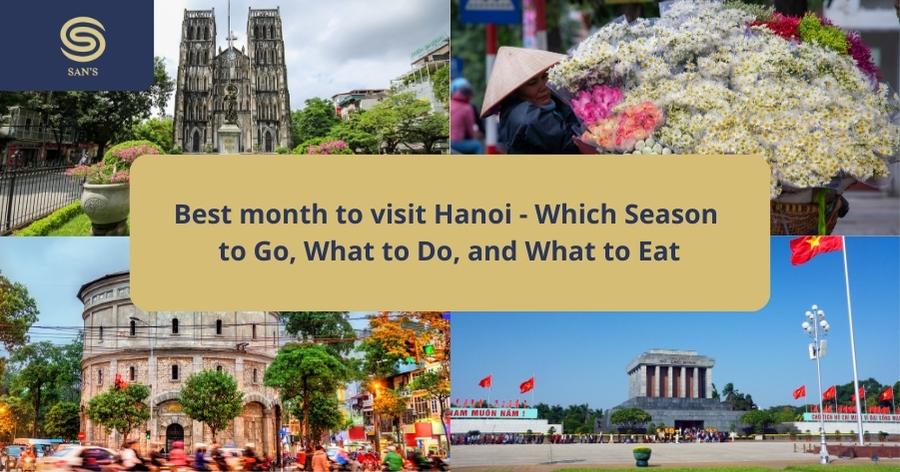Nestled amidst the kinetic energy of Hanoi, where the hum of motorbikes and the aroma of street food converge, lies a tranquil expanse of water that stands as the city’s heartbeat: Hoan Kiem Lake. Not just a scenic respite from urban hustle, this lake is steeped in legend, offering layers of history that beckon both locals and tourists alike.
-

Hoan Kiem Lake
For the residents of Hanoi, Hoan Kiem is more than a picturesque spot. It’s a tapestry of daily life – a place for morning Tai Chi sessions, introspective strolls, and community gatherings. For tourists, it serves as a window into Vietnam’s soul, an emblem of Hanoi’s blend of ancient lore and modern vigor.
As we embark on this exploration, let’s delve into the multifaceted significance of this cherished landmark, a silent guardian of tales old and new.
Historical Background: The Deep Waters of Time at Hoan Kiem Lake
Centuries before Hanoi’s urban sprawl encircled its shores, Hoan Kiem Lake was already steeped in legend and lore. The lake’s name, when translated, means “Lake of the Returned Sword,” hinting at the rich tapestry of tales it holds.
It is said that in the 15th century, Emperor Le Loi was presented with a magical sword by the Golden Turtle God to defend Vietnam against Ming Chinese invaders. Upon achieving victory, while boating on the lake, a giant turtle emerged, taking back the sword and diving deep into the waters. This event, symbolizing the return of the sword to its divine owner, led to the naming of the lake as Hoan Kiem.
-

Hoan Kiem Lake
But beyond legends, the lake has played a pivotal role in Vietnam’s history. As the city of Hanoi grew and evolved, the lake stood witness to dynastic changes, colonial eras, and revolutionary movements. It has always been a focal point, a place where people gathered, whether to celebrate victories or to voice their aspirations for freedom and change.
Over the years, the lake has not only been a backdrop for important historical events but also an embodiment of Vietnam’s spirit. It captures the essence of resilience and transformation – just as Vietnam has undergone numerous changes throughout history, yet remains deeply rooted in its heritage.
The Legend of the Tortoise and the Sword: Hoan Kiem’s Mythical Tale
In the heart of Hanoi, Hoan Kiem Lake reflects more than just the azure skies and surrounding cityscape; it mirrors a legendary tale that has been passed down through Vietnamese generations, a story where myth meets history, intertwining the fate of an emperor with a divine turtle.
The legend centers around Emperor Le Loi, one of Vietnam’s most celebrated rulers. In the midst of a fierce battle against the Ming Chinese invaders, Le Loi was said to have come upon a shimmering sword with inscriptions indicating its heavenly origins. With this sword, he marshaled his forces, repelling the invaders and bringing peace to the kingdom.
However, the sword’s celestial powers were only lent, not given. One tranquil day, as Emperor Le Loi navigated the serene waters of the lake on a boat, a giant golden turtle emerged from its depths. To the emperor’s astonishment, the turtle communicated its divine intent: to reclaim the sword for the Dragon King, its celestial master.
-

Hoan Kiem Lake
Understanding the heavenly mandate, Le Loi returned the sword, watching as the turtle descended with it back into the watery abyss. In honor of this divine encounter, the lake was named Hoan Kiem, meaning “Lake of the Returned Sword.”
The significance of this tale in Vietnamese folklore is manifold. It serves as a testament to the idea that divine intervention and human determination can coalesce to shape the destiny of a nation. The tale also underscores the impermanent nature of power, symbolized by the temporary gifting of the sword, and the responsibilities of stewardship that come with it.
Today, as locals and tourists stroll by the lake, the legend lives on, immortalized by the Turtle Tower (Thap Rua) standing on a small island near the center of Hoan Kiem. It stands not just as a historical marker, but as a reminder of the mystique, valor, and divine grace that has sculpted Vietnam’s rich tapestry of tales.
Architectural Highlights: Marvels on the Waters of Hoan Kiem Lake
Within the serene expanse of Hoan Kiem Lake, architectural gems rise, each telling a story, each a testament to Vietnam’s rich artistic and cultural heritage. These structures, while rooted in history, are living symbols of Hanoi’s vibrant tapestry of traditions and beliefs.
Ngoc Son Temple:
Perched on Jade Island, the Ngoc Son Temple is a beacon of spiritual and architectural magnificence. Translating to ‘Temple of the Jade Mountain’, this structure, with its intricately carved gates, ornate altars, and paintings, provides a window into Vietnam’s dynastic past.
-

Ngoc Son Temple
Established in the 14th century, the temple underwent significant renovations in the 19th century, bearing influences of both Taoist and Confucian styles. With incense wafting through its corridors, the temple is a sanctuary for those seeking to pay respects to national heroes, including the famed General Tran Hung Dao.
The Huc Bridge:
Connecting the bustling shores of Hanoi to the tranquil Jade Island, The Huc Bridge is impossible to miss with its vibrant red hue. This iconic bridge, whose name translates to ‘Morning Sunlight Bridge’, consists of a wooden structure adorned with classical Vietnamese designs.
-

The Huc Bridge – Hoan Kiem Lake
Every plank, every pillar, and every curve of this bridge echoes the meticulous craftsmanship of Vietnamese artisans. As dawn breaks, The Huc Bridge, bathed in morning sunlight, creates a picturesque sight, inviting visitors to cross over to the sacred temple grounds.
Turtle Tower (Thap Rua):
Standing solitary on a small island near the lake’s center, the Turtle Tower is more than just an architectural marvel; it’s a symbol, an emblem of the enduring legend of the lake. Constructed in the 18th century under the rule of Emperor Thanh Thai, this tower with its stone walls and wooden spire is a testament to the resilience and timelessness of Vietnamese legends.
Though visitors cannot access the tower directly, its silhouette against the backdrop of Hanoi’s skyline serves as a constant reminder of the mythical turtle and the returned sword.
Travel Tips for Hoan Kiem Lake Visitors: Making the Most of Your Journey
-

Hoan Kiem Lake
Best Times to Visit:
- Early Mornings: Witness local life in full swing as residents engage in morning exercises, Tai Chi sessions, and community meet-ups by the lakeside. The calm ambiance and cooler temperatures make it a serene start to your day.
- Late Afternoons/Early Evenings: As the city gears down from its daytime frenzy, the lake becomes a hub of leisurely strolls, vibrant street performances, and the magical play of sunset hues on the water.
How to Reach:
- On Foot: If you’re stationed in the Old Quarter, the lake is within walking distance. It’s a pleasant walk, and you can soak in the local atmosphere.
- By Taxi or Grab: Hanoi has a reliable taxi service. If you’re using apps like Grab, simply set your destination to Hoan Kiem Lake.
- Cyclo Rides: For a traditional touch, hop onto one of the cyclos. These pedal-powered trishaws offer a laid-back, scenic route to the lake, giving you a unique perspective of Hanoi’s streets.
Nearby Attractions and Amenities:
- Old Quarter: Just adjacent to the lake, the Old Quarter is a maze of historical lanes teeming with shops, eateries, and glimpses of Hanoi’s age-old charm.
- Thang Long Water Puppet Theatre: Experience traditional Vietnamese puppetry, with performances that delve into folklore and local tales.
- Various Cafés and Restaurants: The lake’s perimeter boasts an array of dining options, offering both local and international cuisines. Grab a seat with a lake view for an added treat!
Respectful Practices and Guidelines:
- Dress Appropriately: If you’re visiting Ngoc Son Temple or any other religious site around the lake, ensure your attire is respectful, preferably covering shoulders and knees.
- Littering: Always dispose of trash in designated bins. The lake is a cherished landmark, and it’s essential to maintain its cleanliness.
- Wildlife: You might spot turtles or other wildlife in or around the lake. Maintain a respectful distance and avoid any actions that might disturb them.
- Local Customs: Observe and respect local customs. For instance, morning exercises are a communal activity; if you wish to join, do so considerately.
Hoan Kiem Lake – A Tapestry of Tales and Tranquility
As we’ve journeyed through the serene expanse of Hoan Kiem Lake, we’ve unraveled a narrative that dances between the realms of myth and history, nature and urban charm. This isn’t merely a body of water; it’s a canvas on which countless tales have been painted, a reflection of Hanoi’s heart and soul.
From the legendary tale of Emperor Le Loi’s sword to the intricate details of historic structures dotting its banks, the lake is a testament to Vietnam’s enduring spirit. Its calm waters stand juxtaposed against the vibrant energy of Hanoi’s streets, serving as both a refuge and a vantage point to the city’s dynamic pulse.
-

Hoan Kiem Lake
But words, no matter how eloquently penned, can only capture a fragment of Hoan Kiem’s allure. Its true essence is best experienced firsthand – in the golden glow of dawn, the whispered legends of the past, and the harmonious blend of traditions and modernity.
So, dear reader, beyond this narrative lies an invitation. An invitation to wander along Hoan Kiem’s shores, to let its tales wash over you, and to immerse yourself in the tranquil beauty and cultural richness that await. May you forge your own memories upon its banks and discover the countless stories Hoan Kiem Lake continues to tell.
FAQs About Hoan Kiem Lake
1. What does “Hoan Kiem” mean?
“Hoan Kiem” translates to “Lake of the Returned Sword,” drawing its name from the legendary tale of Emperor Le Loi and the magical sword that was returned to the Golden Turtle God in the lake.
2. What are the visiting hours for the Ngoc Son Temple on Hoan Kiem Lake?
Ngoc Son Temple is generally open daily from 8:00 AM to 5:00 PM. However, hours might vary on special occasions or holidays, so it’s advisable to check in advance.
3. Is there an entrance fee to visit the Ngoc Son Temple?
Yes, there is a nominal fee to visit Ngoc Son Temple. It’s best to check current rates before your visit, as they may change over time.
4. How deep is Hoan Kiem Lake?
Hoan Kiem Lake has an average depth of about 1.2 meters, though some sections might be slightly deeper.
5. Are there any activities or events at the lake?
Hoan Kiem Lake is often bustling with activities, especially in the early morning or late afternoon. Locals partake in Tai Chi, aerobics, and jogging. On weekends, the area around the lake becomes pedestrian-only, making it a hub for street performances, traditional games, and other community events.
6. Can I boat on Hoan Kiem Lake?
Boating used to be a popular activity on Hoan Kiem Lake, but as of my last update in 2021, boating was no longer allowed. It’s best to check with local authorities for any recent changes.
7. Are there places to eat or shop around the lake?
Absolutely! The area surrounding Hoan Kiem Lake is peppered with cafés, restaurants, and shops, especially in the nearby Old Quarter. Whether you’re looking for traditional Vietnamese dishes, souvenirs, or a quick snack, you’ll find a multitude of options.
8. Is it true that there are turtles in the lake?
Yes, the lake is famously associated with large freshwater turtles. However, sightings have become rare in recent years. The lake’s turtles are of significant cultural and spiritual importance to the Vietnamese people, often linked with the legendary tale of the returned sword.
9. What’s the best way to get to Hoan Kiem Lake?
If you’re staying in central Hanoi, especially in the Old Quarter, the lake is easily accessible on foot. Alternatively, you can take a taxi, use ride-sharing apps like Grab, or even opt for a cyclo ride for a more traditional experience.
10. Are there any rules or guidelines to follow while visiting?
Visitors should respect local customs and practices. It’s important to dress modestly, especially when visiting religious sites like Ngoc Son Temple. Avoid littering, and always be mindful of the environment and local wildlife.





